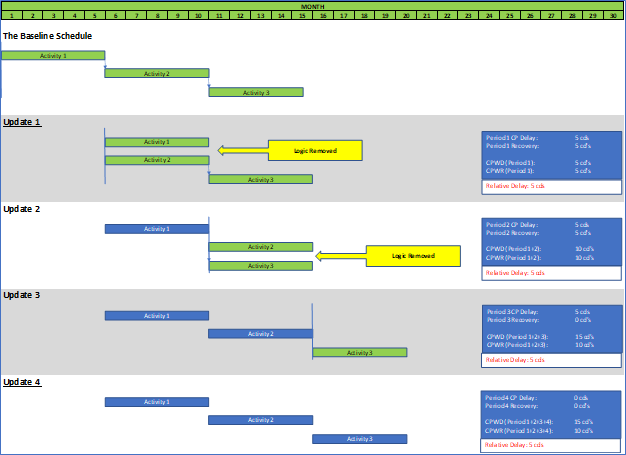Delay is quantified by measuring start and finish variances of activities as compared to the schedule update that immediately precedes it, as loaded into SmartPM™. Critical path delay is quantified by first identifying the historical critical path of the project (using the “half step” methodology) then by studying delay to the activity during the period it was determined to be critical.
SmartPM™ calculates two indexes to assist users in quantifying critical path delay:
- “Critical Path Window Delay” (or CPWD): The summation of the net critical path delay incurred in
each period for all periods analyzed. - “Critical Path Relative Delay” (or CPRD): The net effect of delay on an activity / project at a given point of time as compared to the selected “baseline” schedule.
What’s the difference between CPWD and CPRD?
CPWD is the total summation of the net critical path delay in each window period added up for each period, whereas CPRD is the total delay to an activity (or a series of activities) at a given point in time as compared to the selected baseline. The values for CPWD and CPRD can be the same or different depending on the circumstances. For a given activity or project, these values are generally the same when there are not significant changes in the schedule from one update to the next. However, these values start to become different when more and more changes in the schedule are made – especially added/deleted activities, logic, and modified durations. Figure 1 below illustrates the differences between CPWD and CPRD calculations.
Why differences in delay calculations may occur in SmartPM™ (CPWD vs. CPRD):
Differences in delay calculations in SmartPM™ can arise since SmartPM™ relies on the schedule data, as provided, at different points in time. The CPWD calculation is a sum of the critical path delays in each period, whereas CPRD calculates delay to a given activity as compared to the baseline schedule. These calculations may be different if significant changes were made to the schedules between the first update and the most recent – that were never actually realized. This could cause SmartPM™ to calculate more delay per window than the project would actually be experiencing as compared to the baseline.
For example, as updates occur and changes that were made in previous updates are not actually implemented or achieved, delay calculations can get further and further apart. When these delay calculations are vastly different, a “rebaseline” of the schedule may be warranted. See Figure 1 below:
Figure 1:

In Figure 1 above, the project suffered a 5 day critical path delay to the project, based on the late start of
Activity 1. As a result of this delay, in the first update the scheduler removed a logic tie between Activity 1 and Activity 2. This resulted in the scheduled completion of Activity 3 moved back to where it was originally scheduled in Update 1. The total Critical Path Window Delay (CPWD) is equal to 5 calendar days (cd’s), as is the Critical Path Relative Delay (CPRD).
In the second update period, Activity 1 completes on time and Activity 2 doesn’t start. This pushes the project out 5 more calendar days. Therefore, the Critical Path Window Delay (CPWD) for this period is 5 calendar days or 10 calendar days for the first and second period (5 cd + 5 cd). Whereas the Critical Path Relative Delay (CPRD, the delay relative to the baseline – of work put in place) is 5 calendar days total. This represents the point in time where the two calculations begin to deviate; this deviation occurs only when changes are made to the schedule, work is modified to a state, and then the expected changes are not achieved. When CPWD and CPRD begin to deviate significantly, it is an indicator that the changes being made to the schedule are not being achieved and should be questioned.
Another index that SmartPM™ calculates to better understand the deviation of these two delay calcs is the “Critical Path Window Recovery” (or CPWR). CPWR is the summation of future recovery incorporated in each future period for all periods analyzed. A high CPWR calculation combined with large differences between CPWD and CPRD indicates that the future recovery efforts being built into the schedule are not being realized and the schedule is becoming compressed to a point that is potentially unachievable.
In addition, SmartPM™ has the ability to analyze “critical path” delay to a specific activity or milestone embedded within a CPM Schedule. When analyzing a subset of data, the critical path is defined as the critical path of only the activities that are logically tied to and preceding a given activity or milestone.
Tracking to an activity provides users with the ability to analyze delays related to the achievement of a major milestone or to better understand delays and impacts towards the completion activity of a specific subcontractor’s scope of work.
